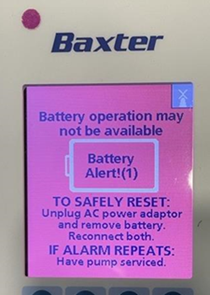|
 
March 2024
Volume 24, Issue 3
The U.S. Food and Drug Administration’s (FDA) MedSun program provides this monthly newsletter to inform patients and patient advocates about FDA information on medical device related topics. The MedSun program, launched in 2002 by the FDA’s Center for Devices and Radiological Health (CDRH), uses a secure online reporting system to receive medical device adverse event reports from a network of over 300 clinical facilities across the United States. MedSun sites work collaboratively with the FDA to assist in detecting, understanding, and sharing information concerning the safety of medical products and play a critical role in the FDA’s postmarket surveillance efforts.
|
|
Letters to Health Care Providers |
|
|
The reports that follow represent a cross section of device related events sent by MedSun Representatives during the prior month. The reports are presented as submitted by MedSun Representatives and in some instances, have been summarized and edited for clarity.
|
|
Type: Ventilator, Continuous, Facility Use
Manufacturer: Hamilton Medical AG
Brand: Hamilton Medical G5
Model: HAMILTON-G5
Cat: 159002
Part Number: 159272
Event: We purchased a batch of 15 Hamilton G5 ventilators over three years ago. Within the past six months, the Alarm Lamp Board failed in 8 of the 15 ventilators, which is a 53% failure rate. This failure results in no visual LED display, red or yellow, when there is an alarm condition. These failures were discovered while our Biomedical Technician was performing routine preventative maintenance.
Device 1:
Type: Bed, Air Fluidized
Manufacturer: HILL-ROM, Inc.
Brand: Envella
Model: P0819A
Device 2:
Type: Ventricular (Assist) Bypass
Manufacturer: Abbott Medical
Brand: Heartmate 3
Event: A Heartmate patient had unexplained pump stops. The patient has a Heartmate device and is critically ill in the ICU post implant. The patient was placed on a Hill Rom Envella specialty bed for an unstageable sacral pressure ulcer and had pump stops. The unknown cause pump stops were reported to the Heart Failure Attending. The patient’s controller and power module were exchanged, but pump stops continued. We sent waveforms to Abbott engineers, who confirmed the pump stops were caused by an electrostatic discharge. We suspected the specialty bed was the origin of the electrostatic discharge. The specialty bed was changed out for a regular ICU bed and more waveforms were sent to Abbott to confirm there were no more pump stops. During the time the patient was on the specialty bed, Abbott confirmed the stops were happening very often (>40 times). Clinical engineering, Heart and Vascular, and the Recall & Defect Team, met with Abbott & HillRom/Baxter. Per HillRom/Baxter, the Envella manufacturer instructions for use (MIFU) only has cautions for EKG and EEG devices, but the manufacturer is considering changes to include other devices and will start testing with an LVAD (Cardiac Left Ventricular Assist Device). Per Abbott, they are unsure if their MIFU contained any information about a specialty bed and will inform their quality team. HillRom/Baxter said at this time they are not testing devices beyond the LVAD for potential interference. Our facility has added an alert in our electronic medical record to alert providers not to order this bed if the patient has a heart pump. HillRom/Baxter have indicated that they are considering including a general warning message in their MIFU to include possible interference from other devices.

Type: Pump, Infusion
Manufacturer: Baxter International Inc.
Brand: Spectrum IQ
Model: 3570009
Cat: 3570009
Event: Our hospital deployed the Baxter Spectrum IQ pump, new high-volume IV pump last spring. Since that time, we have had numerous battery module failures. We have a total of 290 pumps, and the pumps have had this issue for approximately seven months. We sent several pumps to Baxter for evaluation, but there has been no solution because they are still under evaluation. The issue seems to be directly related to the battery module and not the pump itself as we have tried swapping modules and the error follows it to the next pump.
Photo caption: Photo showing alarm on IV pump screen
|
Type: Injector and syringe, angiographic
Manufacturer: Bracco Injeneering SA
Brand: FastLoad CTA Dual Syringe Pack with Spikes
Model: 017355 (x18), 017345, 017354
Cat: 017355 (x18), 017345, 017354
DI: 17630039300873
Lot: 210263, 219067, 229857, 235441, 236163, 235787, 243177, 241077, 239561, 240898, 241677, 240809, 243208, 242411, 24320, 243225, 243410, 244895, 245482, 244589
Event: Multiple MedSun user facilities have reported adverse events when using multiple configurations of the Bracco Injeneering SA EmpowerCTA/CTA+ Consumables including FastLoad CT Syringe Pack with Spike DEHP-Free, FastLoad CT Syringe Pack with Spike, FastLoad CTA Dual Syringe DEHP-Free, FastLoad CTA Dual Syringe, FastLoad CTA Dual Syringe Pack with Spike DEHP-Free, and FastLoad CTA Dual Syringe Pack with Spike. FastLoad CTA Syringes are unexpectedly breaking at various stages during contrast injection procedures. Bracco Injeneering is aware of these recurrent issues and is working to mitigate similar adverse events with FastLoad Syringes from occurring moving forward.
Type: Set, administration, intravascular
Manufacturer: ICU Medical Inc.
Brand: ICU Medical Spinning Spiros
Model: CH2000S-C; CH2000SC-10
Cat: CH2000S-C; CH2000SC-10
Lot: 5985409, 13750328, 13755381; 13794862, 13750328 (x3)
DI: 00840619026615; 00840619042769
Event: Multiple MedSun user facilities have reported incidents where the ICU Medical Spiros Closed System Drug-Transfer (CSTD) Male Luer devices are failing to connect to IV tubing sets during infusion of medication, often during chemotherapy treatments. These issues are causing considerable delays during clinical treatment since medication is oftentimes wasted, forcing pharmacy staff to remake the IV medication.
|
|
Neonatal and Pediatric Reports |
|
 |
|
These reports describe medical device events involving neonatal or pediatric patients, or those events involving a medical device that is indicated for use in neonatal and pediatric patient populations.
The FDA defines pediatric patients as those who are 21 years of age or younger (that is, from birth through the twenty-first year of life, up to but not including the twenty-second birthday) at the time of the diagnosis or treatment.
|
Device 1:
Type: Electrosurgical, cutting & coagulation & accessories
Manufacturer: Megadyne Medical Products
Brand: Mega Soft Reusable Patient Return Electrode
Model: 0845
REF: 0845
Device 2:
Type: Pack, Hot or Cold, Water Circulating
Manufacturer: Gentherm Medical, LLC
Brand: Gelli-Roll Pediatric Size
Model: 194P
LOT: 194P17031
REF: 82198
Device 3:
Type: System, Thermal Regulating
Manufacturer: Gentherm Medical, LLC
Brand: Norm-O-Temp
Model: 111W
Device 4:
Type: General surgery tray
Manufacturer: Medline Industries, Inc.
Brand: Quicksuite
Model: DYKQSuiteL2C
REF: DYKQSuiteL2C
Device 5:
Type: Electrosurgical, cutting & coagulation & accessories
Manufacturer: Covidien LP
Brand: Valleylab FT10
Model: VLFT10GEN
REF: VLFT10GEN
Event: A young child was having adenoidectomy surgery. The operative table consisted of a Gelli-Roll heating pad with a Megadyne Patient Return Electrode Pad on top and then a Sahara Super-Absorbent operating room table sheet, impervious, on top of that with the white-colored cloth side to patient. Next, the patient had a draw sheet under him, above the operating room table sheet. Following the eleven-minute surgery, the patient was brought to the pediatric outpatient surgery area to recover; however, the registered nurse noticed a burn to the patient's right buttock. The patient has been referred to a burn center for evaluation and treatment and may need plastic surgery in the future.
Type: Catheter, Urological
Manufacturer: C. R. Bard, Inc.
Brand: Bardex Lubricath Foley Catheter
Model: 0166L28
Cat: 0166L28
Event: While irrigating the patient’s tube, I was meeting a lot of resistance, and the patient was crying. It also appeared that the tube had come out slightly due to the patient pushing. I reinserted and re-taped the tube before continuing. I contacted another registered nurse to confirm my findings and then contacted the clinical instructor who said there are two ports on the tube. One port was to inflate the balloon, and the other was for irrigation. I was mistakenly attempting to irrigate through was the balloon port, irrigating that port and thus inflating the balloon instead. Additional review found the catheter was a part of a drainage bag system for drawing urine cultures. The catheter itself was a standard Bard urine catheter with a balloon and was not a three-way catheter. The blue port should not be used to instill the saline for a washout. Protocol specifies using a Toomey syringe, not a Luer lock syringe. This is specifically so that we do not instill fluid into the balloon port, which will only accept a Luer lock syringe. In this case, the catheter was being used as a rectal tube, which is not its intended purpose, and the drainage bag was added. This catheter’s port is not intended to be used for rectal washout. The protocol for using this device clearly specifies irrigating the catheter itself with a Toomey syringe because a Toomey is not able to put air or fluid into a side port.
Type: Pediatric Hemodialysis System
Manufacturer: Bellco SRL
Brand: Carpediem
Model: IB7010250 (x2)
DI: 08051736003652
Event: The screens on two Carpe Diem machines were pink in color when the devices were turned on. Data was visible behind the pink screen but was very faint and barely visible.
Type: HeartPacks
Manufacturer: MedLine
Brand: MedLine HeartPacks
Lot: 23FDC379 (x 2), 23FD8084, 23KDA323, 23JDC238 (x 2), 23JDB094, 23JDA610
Event: No patients are involved, and no patient sustained harm. Within the last month, we have discovered contaminants in the open-heart packs. Initially, the hospital thought that this was an isolated incident; however, the vendor, MedLine, provided a fresh lot for us to use, and again we found inorganic debris and film. These contaminants have included a piece of plastic, black debris on Raytec sponges, holes in the outer wrap, and lint balls. Additionally, we found debris on the instruments, such as black flecks and silver flakes from the trays. We found adhesive on green bulb syringes and mayo scissors on two occasions. There was a white powder on a light handle cover, and, in a separate instance, cardboard-like debris was seen on drape. Metal flakes were discovered in specialty cases on two occasions. Hospital staff are aware of this product situation and are diligently inspecting each opened pack.
|
|
Links to FDA CDRH Databases and Other Information Sources |
|
U.S. Food and Drug Administration
10903 New Hampshire Ave.
Silver Spring, MD 20993 |
|
|
|
|